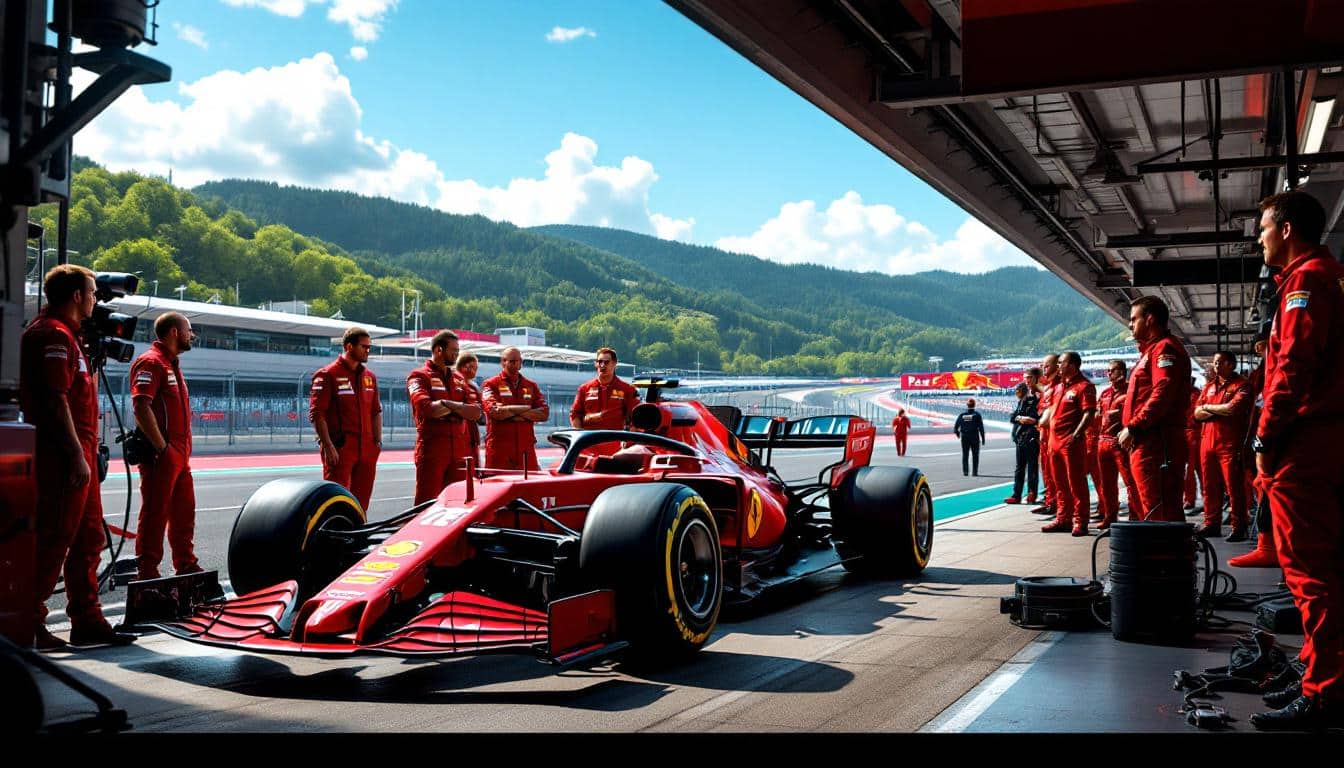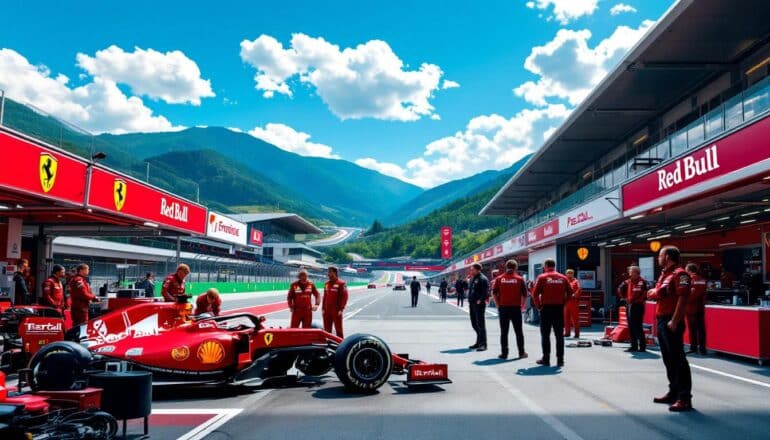The roar of engines, the scent of burning rubber, and the thrill of competition – welcome to the heart of Formula 1. This weekend at the Austrian Grand Prix, a twist awaits us on the pit wall. For the first time since the beginning of the season, a change in leadership will add an extra layer of excitement to the race.
With Fred Vasseur absent due to personal matters, Jerome D’Ambrosio steps up to take charge of the Ferrari team. This will be a pivotal moment for an organization eager to capitalize on a strong grid position. Both Charles Leclerc and Lewis Hamilton are starting from the front, with their impressive qualifying performances putting them in prime positions to chase victory. Hamilton, in particular, is aiming to harness this momentum as he lines up in fourth place, marking his best position since joining Ferrari this season. As the race day unfolds, all eyes will be on D’Ambrosio to see how he manages this exceptional opportunity for the Scuderia. Whether Vasseur will return for the upcoming British Grand Prix remains unknown, but for now, the focus is firmly fixed on Austria and the unfolding drama on the track.

The world of Formula 1 is known for its unpredictable nature, both on and off the track. Recently, the Scuderia Ferrari, one of the most iconic teams in motorsport history, has undergone a significant change in its leadership structure just before the Austrian Grand Prix. This shake-up brings new dynamics to the team as they aim for competitive performances. With the absence of team principal Fred Vasseur for this race, the team will rely on Jerome D’Ambrosio to lead from the pit wall. In this article, we will delve into the implications of this leadership change, what it means for Ferrari’s performance, and how it might influence the race outcome this weekend.
What are the reasons behind Vasseur’s absence?
On the day of the Austrian Grand Prix, Ferrari announced that Fred Vasseur would not be present at the track due to personal reasons. While specifics about his situation remain undisclosed, this development marks the first time Vasseur has missed a race since taking the helm at Ferrari at the beginning of 2023. This situation raises questions about the impacts of his absence, especially at a time when the team appears to have an advantageous position on the grid.
Vasseur’s leadership style has been characterized by his commitment to developing competitive strategies and fostering team cohesion. The timing of his absence is critical, given that race day typically revolves around collaboration and instant decision-making. Jerome D’Ambrosio, stepping in as interim team principal, brings his own experience and insights, having worked closely with Ferrari in various capacities. However, the leadership transition could pose challenges in terms of continuity and stability, as D’Ambrosio navigates the complexities of F1 team dynamics under pressure.
The ramifications of an unexpected leadership change can be profound. The Austrian Grand Prix represents an opportunity for Ferrari drivers Charles Leclerc and Lewis Hamilton to capitalize on strong grid positions, starting second and fourth respectively. The team’s cohesiveness will play a crucial role in their ability to convert these positions into valuable championship points, particularly in a landscape where every point counts in the battle for supremacy.
What does D’Ambrosio bring to the table?
Jerome D’Ambrosio’s appointment to lead the team during the Austrian Grand Prix presents a chance for Ferrari to benefit from his unique insights and experience. As a former F1 driver and a knowledgeable figure within the Ferrari camp, D’Ambrosio is not a stranger to high-pressure environments. His background offers him a deep understanding of the strategies that are vital for maximizing race performance.
He has previously shown his ability to adapt to various roles within a team, and now his key focus will be to maintain Ferrari’s strategy throughout what is expected to be an intensely competitive race. D’Ambrosio’s familiarity with the drivers, particularly with Leclerc, is critical. Both drivers rely on having a clear and responsive communication line with their team, especially during crucial moments of the race.
D’Ambrosio’s ability to uphold the team’s morale during this change also cannot be understated. His presence during a high-stakes weekend, including the potential for the team to score much-needed points, can reassure the drivers and the pit crew alike. As Ferrari sets its sights on a competitive finish, D’Ambrosio will need to balance team confidence while executing effective decision-making during the race.
Additionally, the mechanics and engineering teams will look to D’Ambrosio for guidance as he leads them through potential complexities while keeping the atmosphere positive. This leadership shake-up not only affects strategy but also impacts the human element of Formula 1 racing.
How does D’Ambrosio’s leadership affect race strategy?
With any team, the race strategy is crucial to achieving competitive results. D’Ambrosio’s approach to race day will differ from Vasseur’s based on their varying backgrounds and experiences. On one hand, Vasseur has a wealth of knowledge in executing strategic maneuvers, and on the other, D’Ambrosio will bring fresh ideas and a different perspective to the table, which could be beneficial in adapting to the dynamic nature of F1 racing.
In the face of challenges, D’Ambrosio’s leadership style will likely emphasize collaboration between the drivers and the crew. The Austrian Grand Prix features a unique combination of technical demands and driver skill, requiring quick decision-making regarding pit stops, tire selections, and race tactics. His familiarity with the track integrity and its challenges will play a significant role in devising a viable race strategy.
The team’s immediate goals are to ensure that both Leclerc and Hamilton navigate the race effectively and capitalize on their starting positions. D’Ambrosio’s capability to embrace flexibility will determine how the team responds to unexpected situations as they unfold during the race. This is particularly pertinent considering the potential for incident-driven changes to race dynamics, where adaptability often defines success or failure.
Furthermore, D’Ambrosio has opportunities to leverage collaboration with engineers to optimize performance strategies based on real-time data. The technical aspect of race strategy remains integral, and the way D’Ambrosio leads these discussions can have long-lasting effects on the team’s effectiveness, particularly impacting Ferrari’s standings in the championship.
What implications does this leadership change have for the future?
This abrupt leadership change undoubtedly raises eyebrows about the direction Ferrari is headed, particularly within the 2023 season. Vasseur’s return, whenever it occurs, will be closely analyzed by both fans and analysts alike. Questions will surface regarding how the team will continue to adjust its plans in light of these recent developments. The relationship between Vasseur and D’Ambrosio could be pivotal for the team’s success moving forward.
As the team looks ahead to the British Grand Prix at Silverstone, it will be essential for Ferrari to ensure stability. The question of Vasseur’s potential availability for subsequent races remains unanswered. How Ferrari responds to these uncertainties could set the tone for their season, particularly as they grapple with competitive adversaries like Mercedes and Red Bull Racing.
Moreover, D’Ambrosio’s performance at the helm during the Austrian Grand Prix may influence discussions about the team’s long-term leadership strategy. If he can guide Ferrari to a strong finish, it could bolster his standing within the organization, whereas if the outcomes aren’t as favorable, it might raise concerns regarding team cohesiveness.
The upcoming races will indeed be an essential test for both D’Ambrosio and Ferrari. As the team navigates the twists and turns of the F1 season, the ability to respond effectively to leadership challenges will determine their position on the grid and their ambitions for the championship. Observers will be keenly monitoring how this leadership dynamics play out—stay tuned as the season unfolds.


